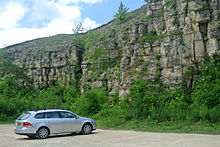
The Oxford Clay is a Jurassic marine sedimentary rock formation underlying much of southeast England, from as far west as Dorset and as far north as Yorkshire. The Oxford Clay Formation dates to the Jurassic, specifically, the Callovian and Oxfordian ages, and comprises two main facies. The lower facies comprises the Peterborough Member, a fossiliferous organic-rich mudstone. This facies and its rocks are commonly known as lower Oxford Clay. The upper facies comprises the middle Oxford Clay, the Stewartby Member, and the upper Oxford Clay, the Weymouth Member. The upper facies is a fossil poor assemblage of calcareous mudstones.

The Purbeck Group is an Upper Jurassic to Lower Cretaceous lithostratigraphic group in south-east England. The name is derived from the district known as the Isle of Purbeck in Dorset where the strata are exposed in the cliffs west of Swanage.

Magnosaurus was a genus of theropod dinosaur from the Middle Jurassic of England. It is based on fragmentary remains and has often been confused with or included in Megalosaurus.

The Kimmeridge Clay is a sedimentary deposit of fossiliferous marine clay which is of Late Jurassic to lowermost Cretaceous age and occurs in southern and eastern England and in the North Sea. This rock formation is the major source rock for North Sea oil. The fossil fauna of the Kimmeridge Clay includes turtles, crocodiles, sauropods, plesiosaurs, pliosaurs and ichthyosaurs, as well as a number of invertebrate species.
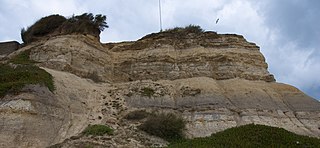
The Wealden Group, occasionally also referred to as the Wealden Supergroup, is a group in the lithostratigraphy of southern England. The Wealden group consists of paralic to continental (freshwater) facies sedimentary rocks of Berriasian to Aptian age and thus forms part of the English Lower Cretaceous. It is composed of alternating sands and clays. The sandy units were deposited in a flood plain of braided rivers, the clays mostly in a lagoonal coastal plain.

Duriavenator is a genus of theropod dinosaur that lived in what is now England during the Middle Jurassic, about 168 million years ago. In 1882, upper and lower jaw bones of a dinosaur were collected near Sherborne in Dorset, and Richard Owen considered the fossils to belong to the species Megalosaurus bucklandii, the first named non-bird dinosaur. By 1964, the specimen was recognised as belonging to a different species, and in 1974 it was described as a new species of Megalosaurus, M. hesperis; the specific name means 'the West' or 'western'. Later researchers questioned whether the species belonged to Megalosaurus, in which many fragmentary theropods from around the world had historically been placed. After examining the taxonomic issues surrounding Megalosaurus, Roger B. J. Benson moved M. hesperis to its own genus in 2008, Duriavenator; this name means "Dorset hunter".
The Kota Formation is a geological formation in India. The precise age of Kota Formation are uncertain, but it dates from the Early to Middle Jurassic, and is split into a Lower Member and Upper Member. The lower member is thought to be Hettangian-Pliensbachian. While the upper unit is thought to be Toarcian, but may possibly extend into the Aalenian. It conformably overlies the Dharmaram Formation which is Late Triassic to earliest Jurassic and is unconformably overlain by the Early Cretaceous Gangapur Formation. The lower member is approximately 100 m thick while the upper member is 490 m thick. Both subunits primarily consist of mudstone and sandstone, but near the base of the upper unit there is a 20-30 metre thick succession of limestone deposited in a freshwater setting.
The Calcaire de Caen or Calcaires de Caen Formation; French for Caen Limestone, is a geological formation in France. It dates back to the mid-Bathonian of the Jurassic. It was often quarried for building work and is referred to as Caen Stone.
The Taynton Limestone is a geological formation in Oxfordshire in the United Kingdom. It dates to the Middle Jurassic, mid-Bathonian stage. It predominantly consists of ooidal grainstone. The term "Stonesfield Slate" refers to slaty limestone horizons within the formation that during the 18th and 19th centuries were extensively quarried for use in roof tiling within the vicinity of Stonesfield, Oxfordshire. Previously these were thought to belong to the Sharp's Hill Formation, but boreholes and shaft sections suggest that at least three horizons within the Taynton Limestone were quarried for the slate. These horizons are well known for producing a diverse set of fossils including those of plants, insects as well as vertebrates, including some of the earliest known mammals, pterosaurs as well as those of first dinosaur ever described, Megalosaurus.
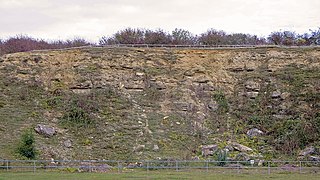
The Forest Marble is a geological formation in England. Part of the Great Oolite Group, it dates to the late Bathonian stage of the Middle Jurassic.

The Blesa Formation is a geological formation in Teruel and La Rioja, Spain whose strata date back to the Barremian of the Early Cretaceous. Dinosaur remains as well as eggs are among the fossils that have been recovered from the formation. Along with the fragmentary anhanguerian pterosaur Iberodactylus. While the lower and upper parts of the formation were deposited in a continental setting, the middle portion of the formation is largely nearshore marine, with remains of plesiosaurs.
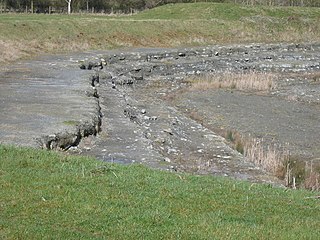
The Cornbrash Formation is a Middle Jurassic geological formation in England. It ranges in age from Bathonian to Callovian, the uppermost part of the Middle Jurassic. Dinosaur remains are among the fossils that have been recovered from the formation, although none have yet been referred to a specific genus. The name Cornbrash is an old English agricultural name applied in Wiltshire to a variety of loose rubble or brash which, in that part of the country, forms a good soil for growing corn. The name was adopted by William Smith for a thin band of shelly limestone which, in the south of England, breaks up in the manner indicated. Although only a thin group of rocks, it is remarkably persistent; it may be traced from Weymouth to the Yorkshire coast, but in north Lincolnshire it is very thin, and probably dies out in the neighborhood of the Humber. It appears again, however, as a thin bed in Gristhorpe Bay, Cayton Bay, Wheatcroft, Newton Dale and Langdale. In the inland exposures in Yorkshire it is difficult to follow on account of its thinness, and the fact that it passes up into dark shales in many places the so-called clays of the Cornbrash, with Avicula echinata. The Cornbrash is of little value for building or road-making, although it is used locally; in the south of England it is not oolitic, but in Yorkshire it is a rubbly, marly, frequently ironshot oolitic limestone. In Bedfordshire it has been termed the Bedford limestone.

The Northampton Sand Formation, sometimes called the Northamptonshire Sand, is a Middle Jurassic geological formation which is placed within the Inferior Oolite Group. It was formerly worked extensively in Northamptonshire for its ironstone.
The Great Oolite Group is a Middle Jurassic stratigraphic unit that outcrops in southern England. It consists of a complex set of marine deposits primarily mudstone and bioclastic ooidal and fine grained limestone, deposited in nearshore to shelf settings. It is exposed at the surface as a variably thick belt extending roughly NE-SW from the coast of Dorset up to the Humber. It is also present at depth in the Weald and Wessex Basins, as well as offshore. Several of the constituent formations, notably the Taynton Limestone Formation and the Forest Marble Formation are notable for their fossil content, including those of dinosaurs and pterosaurs and some of the earliest mammals.
The Kalahari Deposits is an Early Cretaceous (Aptian) geologic formation in South Africa. Dinosaur remains diagnostic to the genus level are among the fossils that have been recovered from the formation. The depositional environment is described as a crater lake where poorly lithified, concretionary conglomerate and volcaniclastic, intraclastic, calcareous mudstone were deposited under quiet subaqueous conditions, probably a "crater-fill succession above an olivine-melilitie intrusion".

The Lealt Shale Formation is a Middle Jurassic geologic formation in Scotland. Fossil ornithopod, theropod and stegosaur tracks, a theropod dinosaur tooth and the pterosaur Dearc have been reported from the formation. The lithology consists of silty fissile mudstones with subordinate thin limestones.
Hadspen Quarry is a stone quarry in Somerset, England. It is shown on Ordnance Survey maps for 1888–90, and may have been in operation for a considerable period before that.
The Rutland Formation is a geologic formation in England. It preserves fossils dating back to the late Bajocian to Bathonian stages in the Jurassic period, about 169 million years ago. It is the lateral equivalent of the Sharp's Hill Formation and the Fuller's Earth Formation. The "Rutland Dinosaur" specimen of Cetiosaurus is known from the formation.
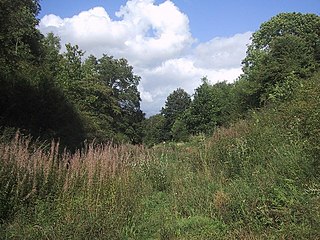
The Chipping Norton Limestone is a geological formation in the Cotswolds, England. It preserves fossils dating back to the Bathonian. Including those of dinosaurs Cetiosaurus, Megalosaurus and Cruxicheiros as well as the Tritylodontid Stereognathus. It primarily consists of ooidal limestone.
The Coralline Oolite Formation is a limestone formation of Oxfordian age, found in the Cleveland Basin of North Yorkshire, England.
